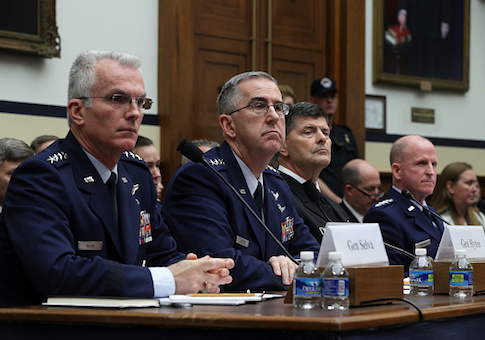The U.S. military is relying on zero-hour modernization to maintain its aging nuclear arsenal as an effective deterrent against adversaries, according to two top U.S. generals.
Gen. Paul Selva, vice chairman of the Joint Chiefs of Staff, testified before the House Armed Services Committee that the United States cannot defer nuclear modernization without "significant risk" to its deterrent capabilities, particularly as other countries like Russia and China are working to revolutionize their forces.
"These systems will not remain viable forever. In fact, we are now at a point where we must concurrently recapitalize each component of our nuclear deterrent," Selva testified Wednesday.
"As a result of previous delays and deferrals, all considered, we are currently depending on just-in-time modernization and replacement of many components of our nuclear triad," he continued.
The U.S. nuclear triad is composed of three legs: land-based intercontinental ballistic missiles (ICBMs), strategic bombers, and submarine-launched ballistic missiles. Gen. John Hyten, commander of the U.S. Strategic Command, warned that most of the platforms, weapons, and infrastructure that support the triad, such as the Air Force's ground-based Minuteman III ICBM and B-52 bombers, are several decades old and have already been extended well beyond their intended lifespans.
"We have made several considered decisions over the last decade to defer some modernization of [the U.S. nuclear deterrent] force in order to address urgent needs while still maintaining a safe, reliable, and secure arsenal and delivery capability," Selva said. "But in making those decisions we have squeezed about all the life we can out of the systems we currently posses, and so that places an extra premium on a very deliberate long-term investment strategy to replace those systems as the existing systems age out of the inventory."
The non-partisan Congressional Budget Office projected in February that the current nuclear modernization plan would cost the federal government an estimated $400 billion over the next decade.
Selva said that while the cost appears substantial, it would ultimately represent less than 1 percent of the nation's anticipated federal spending and approximately 6 percent of the defense budget.
Some work is already underway to upgrade U.S. nuclear forces. Northrup Grumman was awarded a contract to modernize the current B-2 and B-52 bomber force in November. The government also is funding development of the Columbia-class nuclear missile submarine to replace the Navy's current force.
But the government has not yet determined what will replace Boeing's aging Minuteman III under a program called the Ground Based Strategic Deterrent. The Air Force submitted requests for proposals to replace the weapon in July. An Air Force spokesman told CNBC on Tuesday that the first contract award could be announced as soon as the fourth quarter of fiscal 2017.
Pressed by lawmakers to state which piece of the nuclear triad should be prioritized in upcoming budget talks, Hyten equated it to "choosing among your children."
"Under the current construct of what deterrence is, I can't give up any element of the triad," he said. "All three have to be modernized and all three have to be monitored as you go through that."
President Donald Trump has outlined nuclear modernization as a top defense priority for his administration. A week after his inauguration, Trump directed Defense Secretary James Mattis to initiate a new Nuclear Posture Review to ensure the United States maintains a credible nuclear deterrent.
